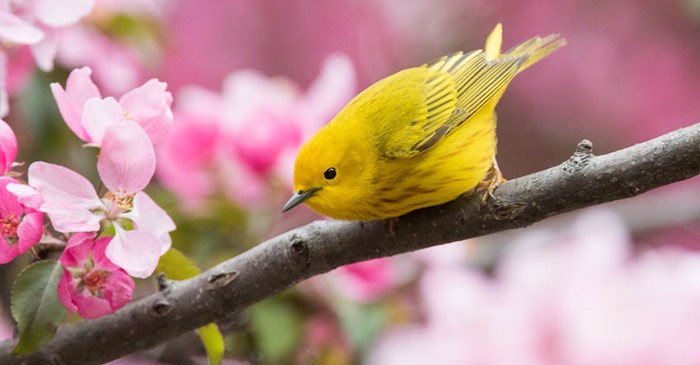Spring is prime time for birding. As our feathered friends migrate to their spring breeding grounds, they’ll be active and busy, competing for partners, scouting for nesting sites and taking on the demanding duties of caring for their helpless young. And of course, through it all, the males will be singing. To get ready, here are five species that bird lovers are waiting for.
Yellow Warbler
Serious birders keep their eyes peeled for a chance to be the first to spy a flash of the sunshine yellow feathers of the Yellow Warbler. In March, they depart from their winter grounds in Central America and start winging their way north. By May, you’ll find them nesting along rivers and streams across the northern U.S. and Canada. These insect eaters don’t visit feeders, but these beauties are worth watching for.
Eastern Bluebird
Consider setting up a nesting box for the Eastern Bluebird, should you happen to live near their habitat. They’re relatively easy to observe (from a safe distance) as they move through that springtime cycle of courtship, nesting and rearing chicks. They don’t often visit feeders, but will approach when there are finely chopped seeds in the mix, such as those found in Lyric Fine Tunes No Waste Mix.
Baltimore Oriole
These orange and black birds with the sweet whistling song stick to a diet of deep-colored fruit and insects and are quite at home in urban areas and parks. Draw these backyard favorites in for an up-close look by setting out orange halves and jelly.
Red-winged Blackbird
For many, the distinctive trilling "chonka-reeeee!” song of the Red-winged Blackbird is the soundtrack of warming weather. As they nest along marshy areas and other wet places, males perch on reeds and shrubs, defending their territories, their food sources and their nesting females, as they call and puff out their feathers to display their red and yellow shoulder badges. They love the chunky seeds and grains found in Lyric Cardinal Premium Sunflower and Safflower Mix.
Western Meadowlark
The meadowlark doesn’t travel far to return to its nesting lands. But its flutey song has gladdened and inspired many generations of hearts after a winter thaw. This brown bird with the bright yellow breast will choose a fence, power pole or some other high vantage point to sing. Scatter Lyric Supreme Wild Bird Mix on the ground, and they’ll drop in to eat the sunflower seeds and cracked corn.
